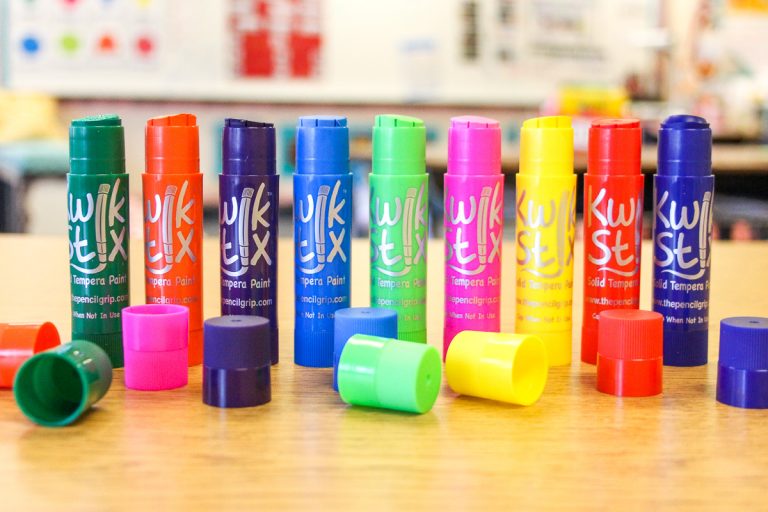

Spring has sprung and all of the “creature” studies are well underway in so many classrooms across the country. I’ve noticed many blog postings describing various bird eggs and hatchlings: Decorah Eaglets, quail, ducks, and more. This seems like the perfect moment to share a really exciting observation and learning experience my kindergarteners had a few years ago when we observed a family of birds right outside my classroom window.
I have a birdhouse mounted to the exterior of my classroom windowsill. It’s a bluebird nesting box that was specially built as a gift for use in my classroom. The bottom and 3 of the sides are made of wood, and the wooden top has hinges to open and close the box. The really cool part is the back wall of the birdhouse. This is made of plexiglass and it is mounted against my classroom window so students can peer inside for an up-close look at the development and early life stages of a bird.
During the springtime debut of my birdhouse, I was always looking inside hoping to find evidence of birds. After repeatedly peeking into the box and seeing it empty, I was thrilled when I finally looked inside and discovered that it was full of earth materials (moss mostly moss and fur) and had chickadee eggs buried deep inside. After a few weeks, the eggs hatched!
Please excuse the early photos (it took several attempts before I figured out the best angle for photos from within my classroom to avoid window glare and flash issues.) Eventually, I was able to capture a few pretty great photos. It’s almost comical to watch the development of the birds as they begin to outgrow the nesting box.
(Thanks to the plexiglass, all of these photos were taken from INSIDE my classroom!)
Chickadee Eggs
Black-caped Chickadees soon after hatching
First feathers on the baby birds
All cozied up
Getting crowded in the nest
My students and I couldn’t get enough of these little birds. We were always peeking into the nest. There is an educational value in hatching eggs in a classroom incubator, but this experience had WAY more to offer since we were able to watch all the family dynamics as these young birds developed. It was a truly touching and exciting time in our classroom.
First of all, find out what kinds of birds nest in your area. Bluebirds are common in my part of Michigan (hence the bluebird nesting box.) It was just a bit of a fluke that chickadees also like the same type of homes as bluebirds. You will also need to investigate what appropriate nesting boxes for the birds in your areas. I was shocked to discover that birds can be very fussy about their housing dimensions. Even the size of the entrance hole is important. I cannot emphasize the value of bird research enough.
Once you do your research, you’ll need to create a nice, inviting environment for the birds. Here are some general guidelines:
Build your birdhouse, then get it outside as soon as possible.
Birds hate fresh wood. Their home should look and feel as natural as possible. Avoid painting and decorating your birdhouse. It’s a waste of time. Build it, then let it sit in the sun, rain, wind, snow, and everything else so it has plenty of time to weather. Chickadees begin hunting for homes during the winter so the sooner you get your birdhouse outdoors, the better.
Provide privacy.
Birds won’t volunteer to have people staring into their homes all the time. You don’t want to scare them away. I taped a dark piece of felt to the window. Lifting the felt allowed the students to peek inside of the birdhouse, and the dark color prevented excessive amounts of classroom light from entering the birdhouse. The darkness provided the birds with a sense of security which encouraged nesting.
Beware of predators.
I was very fortunate to have a tall hedge in front of my classroom windows at the time. The hedge was essential to the security of the birds. It was tall enough to block view of the birdhouse an provided plenty of space for the chickadees and other birds to hop around and find food. Sadly, the hedge removed shortly after the chickadees left the nest. The bushes were definitely an eyesore and the school looks so much better without the hedge, but sadly, the chickadees have not returned since the hedge was torn out. Now the birdhouse is too exposed for predators.
One of the parents hiding out in a nearby hedge
Also beware of wasps. Since the success of my birdhouse, a few others have been added around the school. We’ve noticed that wasps occasionally come to make a cozy home for themselves as well. Just keep an eye on it and find a brave soul remove any nests made by these pests.
No more hedge outside my classroom…
…Equals a sad, empty birdhouse
The birdhouse still sits in my classroom window (on the off-chance that a sad, desperate, or lazy bird family will come along and be happy for the new home). I know that this is not likely, but a girl’s got to hope for something 🙂


I’m a former kindergarten teacher turned work-from-home mom. I still love sharing ideas and resources to make teaching easier, so you can focus on what really matters in the classroom. When I’m not working on the blog, you’ll find me chasing kids around the house with a cold cup of coffee in my hand (some things never change even once you’re out of the classroom!)

©2021 Kinder Craze. All Rights Reserved.

3 Responses
I love this idea! I am so doing this next year :0) I wonder if you could do a bat house this way too?
a bat house would be amazing. If you pull it off, please take pictures!
Have you thought about putting a potted tree or bush in front of the house to encourage nesting? I am going to try this – we watch the Decorah Eagle cam every year- this would be a GREAT addition!